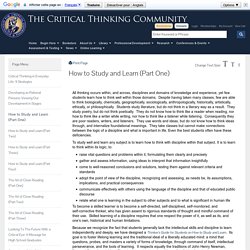

Flip This: Bloom’s Taxonomy Should Start with Creating. Teaching Strategies Chris Davis, Powerful Learning Practice LLC By Shelley Wright I think the revised Bloom’s Taxonomy is wrong.

I know this statement sounds heretical in the realms of education, but I think this is something we should rethink, especially since it is so widely taught to pre-service teachers. I agree that the taxonomy accurately classifies various types of cognitive thinking skills. Conceived in 1956 by a group of educators chaired by Benjamin Bloom, the taxonomy classifies skills from least to most complex. Many teachers in many classrooms spend the majority of their time in the basement of the taxonomy, never really addressing or developing the higher order thinking skills that kids need to develop. Rather than starting with knowledge, we start with creating, and eventually discern the knowledge that we need from it. Here’s what I propose: we flip Bloom’s taxonomy. Creating at the Forefront In media studies we often look at the creation of print and digital advertisements.
Topics - Common Core, Differentiated Instruction, 21st Century Skills. Differentiated Instruction with UDL. By Tracey Hall, Nicole Strangman, and Anne Meyer Note: Updated on 11/2/09; 1/14/11; Please visit the AIM Center home page.

Introduction Not all students are alike. Based on this knowledge, differentiated instruction applies an approach to teaching and learning that gives students multiple options for taking in information and making sense of ideas. Differentiated instruction is a teaching theory based on the premise that instructional approaches should vary and be adapted in relation to individual and diverse students in classrooms (Tomlinson, 2001). This report on differentiated instruction and UDL begins with an introduction to differentiated instruction in which we provide the definition, a sampling of considerations and curriculum applications, and research evidence for effectiveness. The literature review in this paper is also available as a stand alone document, with annotated references. Top Definition Figure 1. Identifying Components/Features. Four Things All Educators Should Understand About the Dyslexic Brain.
What do you think of when you hear the word dyslexic?

All too often the reflex reaction is a stream of negative associations -- "slow reader," "under performance," "extra time on exams," "difficulty spelling. " While it is true that these are common symptoms in students with dyslexia, they are surmountable problems. For any educator, the key to unleashing academic success in dyslexic students lies in understanding how their brains work. A recent Edutopia blog post by Judy Willis made the case for adding neuroscience to the curriculum for student teachers.
When it comes to tackling dyslexia in the classroom, this understanding would be hugely beneficial, as it would help teachers explain to students exactly why they are having problems and what they can do to overcome them. Here are four key characteristics of the dyslexic brain that are crucial for educators to understand. 1. A dyslexic can typically do one of those things but will struggle to do all of them in sequence. 2. 3. Category. Drawing Autism: Self-Expression by Children & Artists. By Maria Popova What the spectrum of difference has to do with 12th-century demons and Google Earth.

Autism is one of the greatest modern mysteries of cognitive science, a highly faceted condition that remains largely misunderstood. We’ve previously explored several notable autistic outliers — British savant Stephen Wiltshire, who draws remarkable 3D panoramas of cities from memory; animal scientist Temple Grandin, who is equally well-known for her innovations in livestock herding and her autism advocacy; and autistic savant Daniel Tammet, who was able to learn Icelandic in a week, among other remarkable feats of memory. But what is the actual experience of living with autism in a deep felt sense, beyond the social stereotypes and headline-worthy superskills?
Drawing Autism, a celebration of the artistry and self-expression found in artwork by people diagnosed with autism, explores just that. Felix: Imaginary City Map, Age 11 Who are some artists that you like? Vehdas Rangan: A. Emily L. Coursera.org.
Terrific Tools for Teaching with Bloom's Taxonomy - Home. Random, Interesting, Amazing Facts - Fun Quizzes and Trivia. About Prelude ‹ Heliotrope. About Prelude Prelude is a group learning game that fosters 21st Century Skills and Social & Emotional Literacy . This includes: self knowledge, empathy, creativity, communication, collaboration, and appreciation for diversity. These skills are key to success throughout life. They are essential to civil society. Prelude is an ideal way to start a school term or training program. PocketLiteracy - Accelerate Your Child's Literacy and Learning. Educurious. Education Week American Education News Site of Record.
Play theory. Special Needs. Math sites. How to Study and Learn (Part One) All thinking occurs within, and across, disciplines and domains of knowledge and experience, yet few students learn how to think well within those domains.

Despite having taken many classes, few are able to think biologically, chemically, geographically, sociologically, anthropologically, historically, artistically, ethically, or philosophically. Students study literature, but do not think in a literary way as a result. They study poetry, but do not think poetically. They do not know how to think like a reader when reading, nor how to think like a writer while writing, nor how to think like a listener while listening.